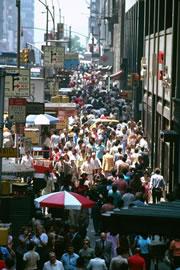 Innovate or die: big cities need to rush to keep feeding their growth.Punchstock
Innovate or die: big cities need to rush to keep feeding their growth.PunchstockVisitors to New York City often chafe at being jostled out of the way as city residents rush by. But if it seems as though New Yorkers think their time is more precious than yours, new research suggests there may be a good reason: it is.
Whether New York or Tokyo, London or Shanghai, a city's continued success is dependent on the social networks that drive innovation, new mathematical models show. The bigger the city, the faster that innovation needs to keep coming if it is to support the city's population growth. That means that city dwellers literally need to move fast — they've got to squeeze more activities into their day and boost the chance that they'll make new social contacts. The fate of their city could hang in the balance.
"Cities are social accelerators," says mathematician Luis Bettencourt of Los Alamos National Laboratory in New Mexico, who led the research. "Everything's speeding up."
Society has quietly crossed a threshold over the past few years as urban populations grew larger than rural communities for the first time in human history. By 2030, urban populations in developed countries will have grown by as much as 20%, as cities in developing countries balloon to more than twice their current population and three times their current land area.
The consequences of that shift are anxiously awaited and largely unknown. Cities are often centres of pollution, disease and crime. But they also concentrate people in one location, facilitating interaction, fuelling innovation and making it more efficient to supply the population with basic needs such as energy, education and health care.
Urban statistic
“You have to run just to stand still in the bigger cities.”
Michael Batty, an urban planner at University College in London.
To model city growth, Bettencourt and his colleagues gathered a wide-ranging swath of statistics about cities in the United States, Europe and China, including the number of new patents originating from that city, the amount of water and electricity used by each household, the total length of electrical cable needed to wire them up, and the number of AIDS cases.
They then looked at theoretical models of resource consumption and population growth to see how cities grow. A city where population growth is fuelled predominantly by infrastructure (such as the building of the electricity grid) would reach an eventual population limit, they show. But one fuelled mainly by personal needs (such as housing) would grow exponentially. And one that is fuelled by innovation, and can maintain an accelerating rate of innovation, could, theoretically, explode in growth indefinitely (see How does your city grow)1. New York, they say, most closely follows this last pattern.
In reality, however, cities typically go through boom-and-bust cycles of accelerating growth followed by dramatic population crashes. "All of a sudden it becomes too costly," says Bettencourt. "There's too much crime, too much congestion, and people start leaving. The city has to take a breather and start a new cycle of growth."
What Bettencourt calls "a breather", city planners might call a collapse. New York, for example, underwent its largest expansion in history during the 1960s and 1970s, only to crash in the late 1970s when poor living conditions began to drive out segments of the population.
Nevertheless, that wasn't the end of New York, Bettencourt points out. The city's economy rebounded, and is now bigger than that of India or Brazil, he says.
Never-ending boom
The results suggest a course of action for city planners who want to maintain their boom and stave off their bust. "If they want to keep on this treadmill, then individual cities may want to accelerate innovation and social interaction," says Sander van der Leeuw, an anthropologist at Arizona State University in Tempe who has collaborated with the study authors on related projects. That could mean focusing on building universities or cultural centres where people can mix and share ideas, for example.
ADVERTISEMENT
In the meantime, these societal trends are not locked in stone. Now that we have the Internet, says van der Leeuw, we may be able to get this networking without all living together. "But we're not at that stage yet culturally," he says.
Bettencourt's team has not yet evaluated the environmental impacts of urbanization — a key concern as cities grow around the world. Even so, the current models will answer key questions that economists have debated for decades, says Michael Batty, an urban planner at University College London. And it helps to explain more intuitive observations. "I've lived in different sized cities," says Batty, "and you certainly do feel that you have to run just to stand still in the bigger ones."
Visit our citiesneedafastpaced_li.html">newsblog to read and post comments about this story.
